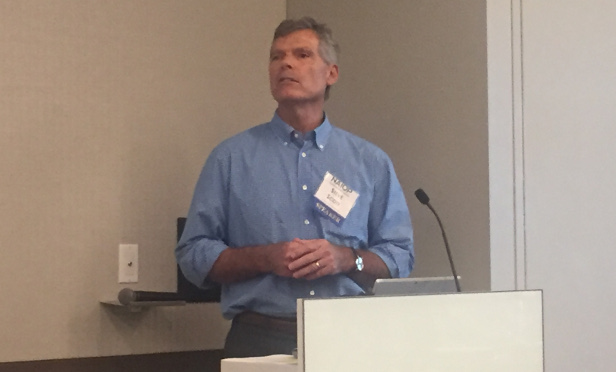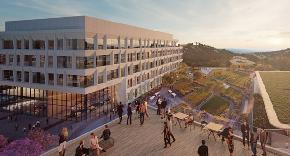 Scott: “Young leadership needs to have a voice in what is needed. That’s what’s missing from the decision-making table.”
Scott: “Young leadership needs to have a voice in what is needed. That’s what’s missing from the decision-making table.”
SAN DIEGO—Thinking outside the box, busting silos and voicing opinions are necessary for San Diego’s development sector to be proactive instead of reactive, Cisterra Development partner Steve Scott told the more than 100 NAIOP Developing Leaders Lunch and Learn series attendees Wednesday. Scott led a presentation aimed at motivating young CRE professionals in the development realm to put themselves forth and be leaders instead of followers in order to make San Diego a more forward-thinking market.
“Real estate is all reactive, but the customer is focused on the future, which is counterintuitive,” Scott said. In citing some of today’s most innovative companies, Scott said doubtless their founders never sat in a conference room and listened to a guy like Scott telling them how to be successful in real estate; instead, they were forward-thinkers who made their dreams come true.
Scott talked about some of the obstacles to successful development, particularly in San Diego, including government members who aren’t interested in solving problems with the real estate community. “Regional leaders, council members, mayors, etc.—we don’t hear from them. But there’s a housing shortage, and what are city leaders doing to solve this? They’re takers, but we are problem solvers.”
Looking at leadership, Scott asked why the Bay Area is outperforming Southern California, citing universities, intellectual capital and transportation that’s superior to San Diego’s especially—although trolley patterns are changing, and Westfield is investing $1 billion in San Diego, so progress is being made. But overall, “San Diego leadership is weak, myopic and reactive.”
He asked rhetorically what would San Diego look like without life sciences? “Where there be the intellectual capital here to attract companies? If you take out life sciences, what would the absorption and rental rates be? Most likely, investors would look at San Diego and say it’s not a good investment.”
Scott pointed out that the development process is always changing, so developers need to be aware of several things and how they could change their projects including the political environment, the city/community infrastructure and fiscal strength, environmental conditions and building-code updates and changes. “You need to anticipate and hedge against these things and assess your risk.”
Developers also need to focus on their customer, the user, said Scott. Who are they and why? What makes them great? What are their infrastructure needs and how are these needs changing? He said Alexandria Real Estate Equities—a developer of mostly life-sciences office product—is one of the best examples of a company that understands its customer.
He also said it’s important to consider one’s future customer. Who are they? What is the value proposition of your project for them? How do you meet future capex needs and ongoing operation costs for this customer?
Next, Scott addressed the importance of assembling a team that is knowledgeable, has customer and industry relationships, has community and staff relationships and understands and embraces the budget and schedule for your project. “It seems like the developer is the only accountable point of the process, but everyone on the team should be accountable.” He said having a bonus pool is a good strategy because it will motivate others to cover for a weak link and make them stakeholders in the project.
Scott talked about expecting the unexpected when developing projects. “There’s always an opponent,” he said, displaying a picture of disgraced former San Diego mayor Bob Filner. Some common pitfalls for development projects include: it always takes longer and costs more than expected, everyone has a hidden agenda and EIRs are the ultimate quick-sand delay and can even destroy a project.
Lastly, developers need to create an exit strategy based on what the return is to the team, lenders, equity partners, mezzanine, JV partners, the community and lastly—you. “Now go build—that’s the easy part. It’s a great rush and very rewarding to see a project built.”
Throughout his presentation, Scott stressed the importance of the younger generation of commercial real estate professionals telling the older generation what to build. “Young leadership needs to have a voice in what is needed. That’s what’s missing from the decision-making table.”
Scott said developers need to look outside the industry for inspiration—to their customers in life sciences, financial services, even Google, in order to understand their needs. The challenge, he said, is that “the development community has failed at developing solutions that really benefit our community. We need to develop solutions that bring benefits to all stakeholders and investors.”

















 Copyright © 2024 ALM Global, LLC. All Rights Reserved.
Copyright © 2024 ALM Global, LLC. All Rights Reserved.